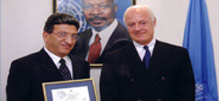Arab world faces worsening water crisis: report
(Reuters) - The Arab world, one of the driest regions on the planet, will tip into severe water scarcity as early as 2015, a report issued on Thursday predicts.
By then, Arabs will have to survive on less than 500 cubic meters of water a year each, or below a tenth of the world average of more than 6,000 cubic meters per capita, said the report by the Arab Forum for Environment and Development (AFED).
"The Arab world is already living a water crisis that will only get worse with inaction," the report says, adding per capita supply has plunged to only a quarter of its 1960 level.
Rapid population growth will further stress water resources. According to U.N. projections, the Arabs, who now number almost 360 million, will multiply to nearly 600 million by 2050.
Climate change will aggravate matters. By the end of this century, Arab countries may experience a 25 percent drop in precipitation and a 25 percent increase in evaporation rates, according to climate change models cited in the report.
"As a result, rain-fed agriculture will be threatened, with average yields estimated to decline by 20 percent," it says.
Thirteen Arab countries are among the world's 19 most water-scarce nations. People in eight Arab countries already have to make do with less than 200 cubic meters a year each.
"Without fundamental changes in policies and practices, the situation will get worse, with drastic social, political and economic ramifications," the AFED report says.
Conditions vary across the region, but within five years only Iraq and Sudan will pass the water scarcity test, defined as over 1,000 cubic meters a year per capita, assuming supplies from Turkey and Ethiopia still flow at current levels.
Agriculture consumes 85 percent of Arab water use, compared with a world average of 70 percent. Irrigation efficiency is only 30 percent, against a world average of 45 percent.
Groundwater is over-exploited, leading to significant declines in water tables, pollution of aquifers and seawater intrusion in coastal areas, AFED says. More than 43 percent of wastewater is discharged raw, while only 20 percent is reused.
The Arab world has 5 percent of the world's population but only 1 percent of its renewable fresh water, so several Gulf Arab countries rely heavily on desalinated sea water -- accounting for more than half the world's desalination capacity.
GOLF COURSES IN THE DESERT
Some of the expensive desalinated water is used to irrigate low-value crops or even golf courses, the AFED report says.
Discharge from the desalination plants, which use imported, polluting technologies, makes sea water warmer and more saline.
Despite its scarcity, water is often squandered in the Arab world thanks to low prices and subsidies that disguise its cost.
"Free water is wasted water," the report says, noting average prices charged in the region cover 35 percent of water production costs and only 10 percent for desalinated water.
Governments, which often focus on seeking new supplies of water, should instead concentrate on improving water management, rationalizing consumption, encouraging reuse and protecting water supplies from overuse and pollution, AFED urges.
Better water management presents huge challenges in Arab countries where most public organizations serving irrigation and urban water needs "do not function properly."
Water pricing schemes are needed to attract new investment in the sector, but that will not be enough, the report says.
"No technological or engineering solutions will be effective without the necessary policy, institutional and legal reforms."
(Editing by Janet Lawrence)
(For full report see www.afedonline.org/Report/2010/main.asp)
| 



